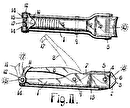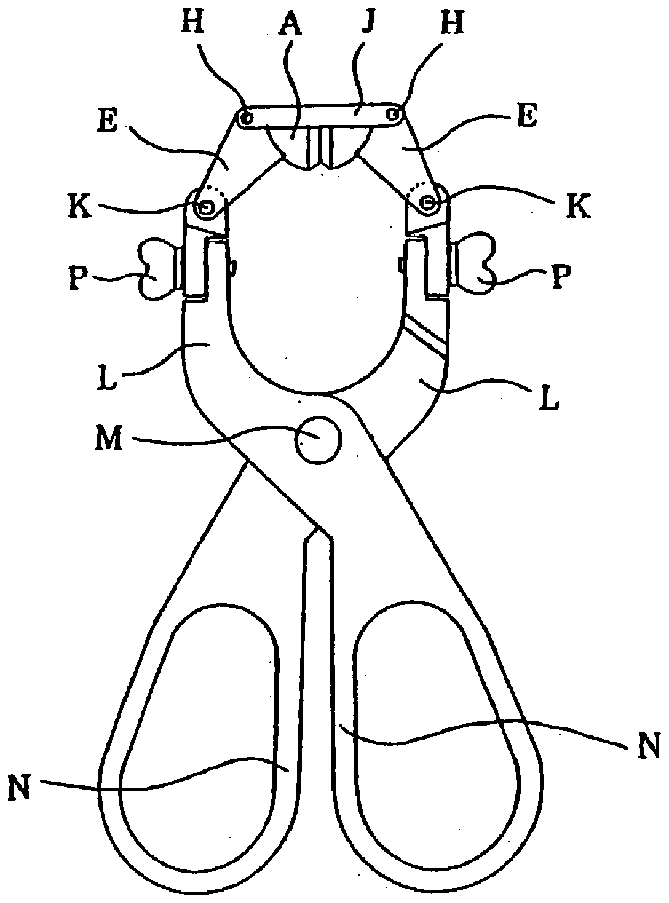
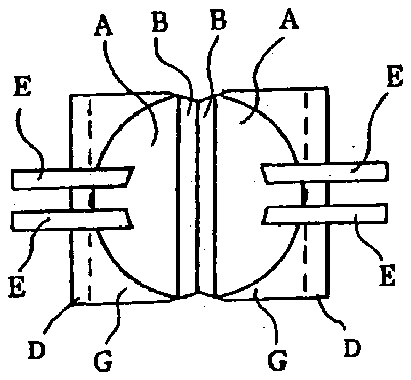
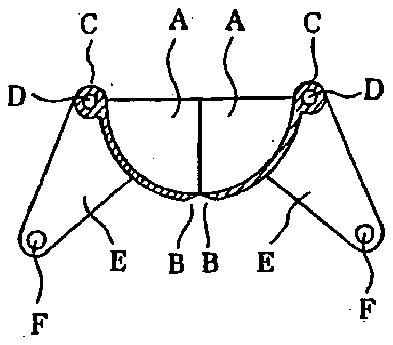
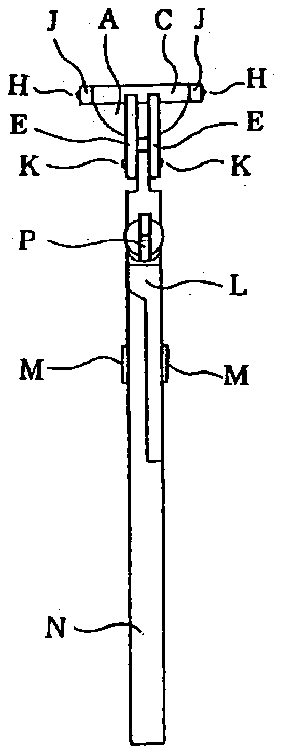
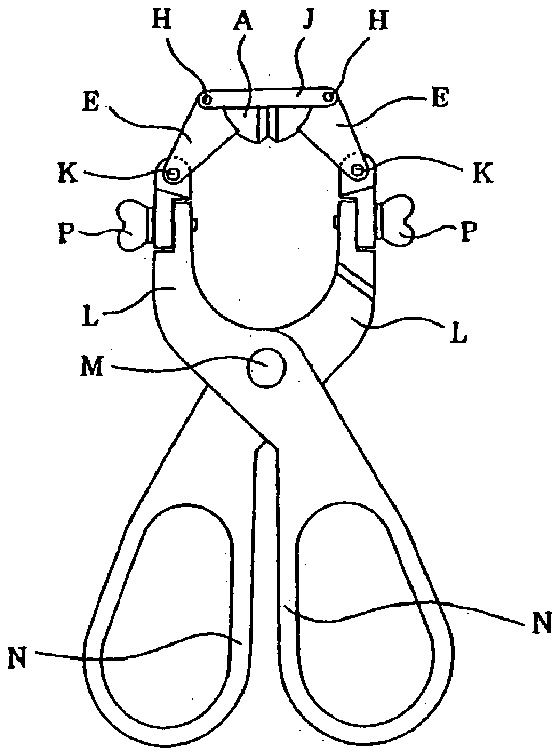
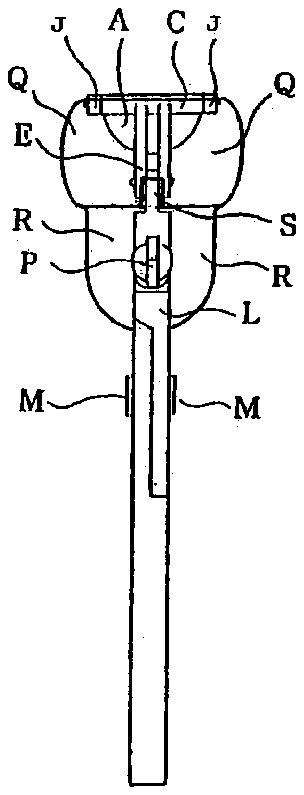
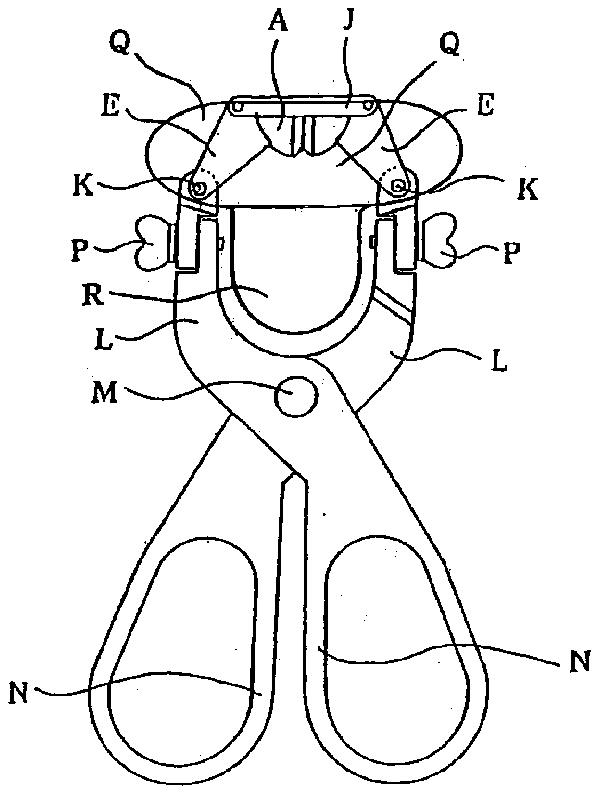
Abstract
A nail clipper for pets has a scissors structure provided with cutting surfaces formed by curved blade pieces. The curved blade pieces are created by dividing a spherical or elliptical body into quarter pieces having a hollow interior and formed with curved cutting edges. The blade pieces are hinged to opposite ends of a holding piece and moved by pivoting parts coupled to the ends of operating parts of the scissors structure. By operating the scissors structure, the curved blade pieces open and come together to cut the pet's nail, producing smooth nail edges cut in a curved shape with a single cutting action.
Description
SPECIFICATION
[0001] 1. Technical Field
[0002] This invention generally relates to a nail clipper for pets, and particularly, to one having a scissors structure provided with cutting surfaces formed by curved blade pieces.
[0003] 2. Background of Invention
[0004] The conventional nail clipper for pets, such as dogs and cats, typically has a straight or slightly curved cutting edge. This presents a problem in that the nail when cut may have a sharp edge.
SUMMARY OF INVENTION
[0005] In accordance with the present invention, a nail clipper for pets has a scissors structure provided with cutting surfaces formed by curved blade pieces. The curved blade pieces are created such as by dividing a spherical body with a straight line into two equal pieces, and further dividing each semi-spherical piece with a straight line into two equal quarter-spherical pieces, with each of the pieces having a hollow interior and formed with a curved cutting edge. Alternatively, the blade pieces may be formed by dividing an elliptical body into equal quarter-elliptical pieces. Each curved blade piece is pivotably mounted to face and abut with each other along their cutting edges. The blade pieces are hinged by hinge parts to opposite ends of a holding piece and adapted to be pivotably moved by pivoting parts coupled to respective operating parts of the scissors structure. By operating the scissors handles, the blade pieces are able to open and close together so as to cut the nail of a pet placed between the blade pieces.
[0006] In a preferred embodiment, each blade piece is attached to a hinge mounting board on an opposite side from the blade cutting edge. One edge of the board mounts a cylinder-shaped hinge provided with a pin hole. Two blade pieces are arranged with their cutting edges facing and touching one another. A pin is inserted through a hole on the end of a holding piece and into each hinge pin hole to connect the blade pieces to the holding piece. Pivoting parts are attached to the respective blade pieces, in order to to open and retract the blade pieces about their axes of rotation. The ends of the pivoting parts are coupled to the ends of two operating parts (arms) of the scissors structure. The two operating parts are coupled across one another at a pivot center, and secured by a rotation pin together. The other ends of the operating parts have scissors handles or grips. By opening and closing the grips, the nail cutter is able to cut the nail of a pet placed between the cutting edges of the blade pieces. The operating parts also have angle adjustment mechanisms at their operating ends to allow for preferential angle setting of the blades relative to the ends of the operating parts. A collecting box may also be attached around the blade pieces for containing and preventing the dispersion of cut pieces of nail. The box may be split into two parts with each part having attachments to connect the two pieces in order to allow for easy detachment of the box from the whole unit.
[0007] Other objects, features, and advantages of the present invention will be explained in the following detailed description of the invention having reference to the appended drawings.
BRIEF DESCRIPTION OF DRAWINGS
[0008] [0008]FIG. 1A is a side sectional view and FIG. 1B is an overhead view of the arrangement of curved blade pieces in a preferred embodiment of a nail clipper for pets in accordance with the present invention.
[0009] [0009]FIG. 2A is a side elevation view and FIG. 2B is a side edge view of the overall scissors structure of a preferred embodiment of a nail clipper for pets.
[0010] [0010]FIG. 3A is a side elevation view and FIG. 3B is a side edge view of another embodiment of the scissors structure of the nail clipper for pets having a collection box for cut nails.
DETAILED DESCRIPTION OF INVENTION
[0011] Referring to FIG. 1A and FIG. 1B, a nail clipper for pets in accordance with the present invention is provided with cutting surfaces formed by curved blade pieces A. The curved blade pieces A are created such as by dividing a spherical body with a straight line into two equal pieces, and further dividing each semi-spherical piece with a straight line into two equal quarter-spherical pieces, with each of the pieces having a hollow interior and formed with a complementary curved cutting edge B. Alternatively, the blade pieces may be formed by dividing an elliptical body into equal quarter-elliptical pieces. Each curved blade piece A is pivotably mounted to face and abut with each other along their cutting edges B. The blade pieces A are attached to cylinder-shaped, metal hinge parts C with pin holes D on the sides of the blade pieces A opposite from the cutting edges B. Pivoting parts E are attached (preferably in parallel pairs on each side for stability) to the respective blade pieces for pivoting them about the axes of rotation of the hinge parts C. Holes F are provided in the pivoting parts E for coupling to the operating parts of a scissors structure (described below). The hinge part C may be formed along one edge of a hinge mounting board G, made of material such as metal, which is attached to the rim of the blade piece A. With this construction, the curved blade pieces A can open and come together to cut the pet's nail, producing smooth nail edges cut in a curved shape with a single cutting action.
[0012] Referring to FIG. 2A and FIG. 2B, a scissor structure is provided for pivotably moving the blade pieces open and closed so as to cut the nail of a pet placed between the blade pieces. Two blade pieces A (left and right) are mounted with their cutting edges B facing and touching one another by inserting a pin H, made of material such as metal, through a holding piece J and into each pin holes D of the hinge part C attached to a respective blade piece A. By pivoting the pivoting parts E, the blade pieces A are thus able to open and retract with the pins H as the center of rotation. The pivoting parts E are coupled to operating parts (arms) L at opposite positions, right and left, by inserting pins K into pin holes formed at the ends of the operating parts L, which is made of material such as metal. The two operating parts L cross one another at a pivot center and are secured together by a rotation pin M, made of material such as metal. Handles or grips N are provided on the opposite ends of the operating parts L for actuating the opening and closing movements. As a further feature, the operating parts are formed with an angle adjustment mechanism at their operating ends. The ends are cut to allow them to be swiveled at an inclined angle and secured in that position by butterfly nuts P, made of material such as metal. The operation of the butterfly nuts P allows for a prefered angle setting of the blade pieces A relative to the ends of the operating parts L.
[0013] Referring to FIG. 3A and FIG. 3B, the nail clipper may also have a box Q attached around the blade pieces A, pivoting parts E, holding piece J, the ends of the operating parts L where they are attached to the pivoting parts, and the hinge mounting boards G. Box Q may be made of transparent plastic material such as a high molecular compound, and its function is for containing and preventing the dispersion of cut pieces of nail. The box Q can be formed with a rectangular-shaped or oval-shaped volume defined within its surface, which is sized to define a perimeter around the holding piece J and the pivoting parts E. The box Q is formed as an attached nail container open at its upper surface for receiving the pet's nail and also has a lower receptacle R and a pair of grooves S formed in its lower surface to allow the operating parts L to move its ends to open and retract. The box Q is split into two parts with each part having hook-shaped attachments to connect the two pieces in order to allow for easy detachment of the box Q from the whole unit.
[0014] As a specific example, the preferred nail clipper can have blade pieces A formed with a 9 mm diameter and 1 mm thickness. It can be made of metal and created by dividing a spherical or elliptical body with a straight line into two equal pieces and further dividing each piece with a straight line into two equal pieces with each of the quarter pieces having a hollow interior and formed with a cutting edge on one side of the blade piece rim. The hinge mounting board G may be made of metal and atached on the opposite side of the blade piece A rim. The board G may be formed with a hinge part C with 3.5 mm diameter and with 1.5 mm diameter pin holes D.
[0015] It is to be understood that many modifications and variations may be devised given the above description of the principles of the invention. It is intended that all such modifications and variations be considered as within the spirit and scope of this invention, as defined in the following claims.
